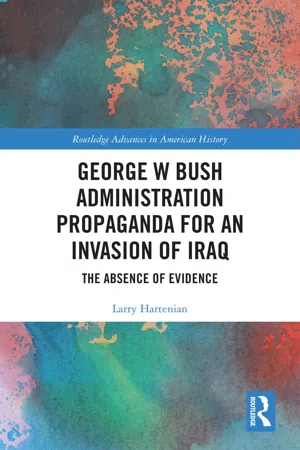
George W Bush Administration Propaganda for an Invasion of Iraq
The Absence of Evidence
- 424 pages
- English
- ePUB (mobile friendly)
- Available on iOS & Android
George W Bush Administration Propaganda for an Invasion of Iraq
The Absence of Evidence
About this book
Hartenian's history of George W Bush propaganda for an invasion of Iraq returns the administration's approach to its conceptual origins. Hartenian places "evidence" in the center of his analysis, showing that Rumsfeld's "the absence of evidence is not evidence of absence" meant that no evidence was necessary to justify an invasion. The 9/11 attacks, indeed, "changed everything" for the Bush administration and in its aftermath the time for regime change in Iraq had simply come.
With no good evidence to support its fears, the administration was certain of a post-9/11-conceived Iraq–al Qaeda "nexus," just as with no evidence except the "absence of evidence" it was certain of Iraqi mastery of "denial and deception" that hid "Saddam's" "evil" activities. Resting on Cheney's "one percent doctrine," administration "certainty" of the threat from Iraq required a US invasion.
The policy offices of Douglas Feith at the Pentagon, with the help of George Tenet at CIA, would generate a case of such fright and enormity—the "mushroom cloud"—that required administration action. Manipulating intelligence and ignoring the growing body of evidence undermining its case, the Bush administration invaded Iraq to bring about "regime change."
Frequently asked questions
- Essential is ideal for learners and professionals who enjoy exploring a wide range of subjects. Access the Essential Library with 800,000+ trusted titles and best-sellers across business, personal growth, and the humanities. Includes unlimited reading time and Standard Read Aloud voice.
- Complete: Perfect for advanced learners and researchers needing full, unrestricted access. Unlock 1.4M+ books across hundreds of subjects, including academic and specialized titles. The Complete Plan also includes advanced features like Premium Read Aloud and Research Assistant.
Please note we cannot support devices running on iOS 13 and Android 7 or earlier. Learn more about using the app.
Information
Part I
The Propaganda Build Up on Iraq in the First Year and One Half of the Bush Administration
1 Bush Administration Views on Iraq in 2001
Early Intelligence Building toward a Propaganda Case
These assessments consistently concluded that the International Atomic Energy Agency (IAEA) and the United Nations Special Commission (UNSCOM) had destroyed or neutralized Iraq’s pre-Gulf War nuclear infrastructure and that Iraq did not appear to have reconstituted its nuclear weapons program.13
- Iraq had maintained some of the intellectual capital and physical infrastructure necessary for a nuclear weapons program.
- Iraq continued to procure “dual use” technologies (i.e., with both nuclear and non-nuclear potential uses).
- Iraq continued low-level, clandestine theoretical research and training of personnel….
- If Iraq decided to restart a nuclear weapons program, with proper foreign assistance, Iraq could produce enough fissile material for a nuclear weapon within 5 to 7 years.
- If Iraq in some way acquired adequate fissile material from a foreign source, it could produce a nuclear weapon within 1 year.14
Table of contents
- Cover
- Half Title
- Series Page
- Title Page
- Copyright Page
- Dedication
- Table of Contents
- Preface
- List of Abbreviations
- Part I The Propaganda Build Up on Iraq in the First Year and One Half of the Bush Administration
- Part II Bush Administration Vigorous Propaganda for an Invasion of Iraq
- Part III Shock and Awe
- Works Cited
- Index